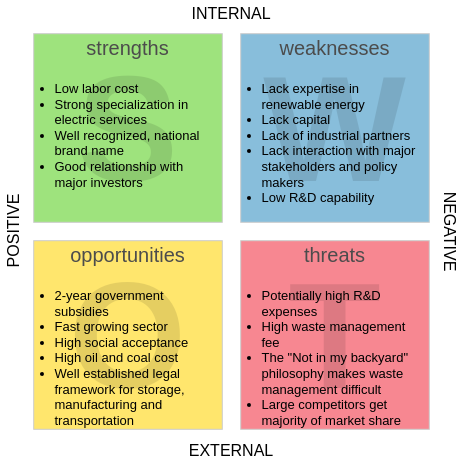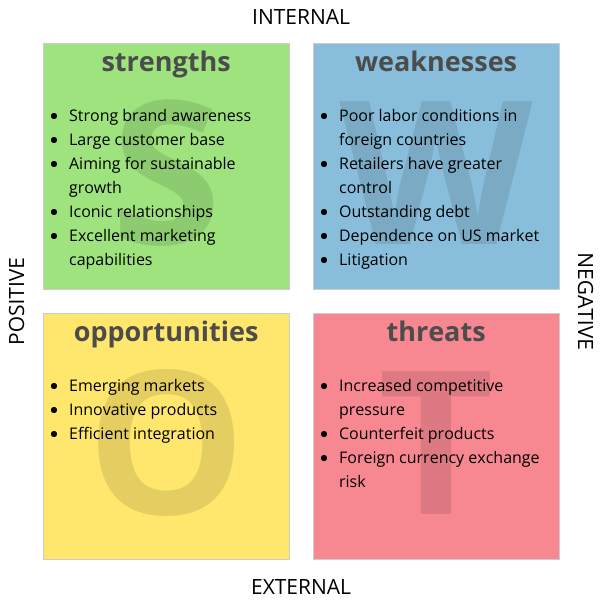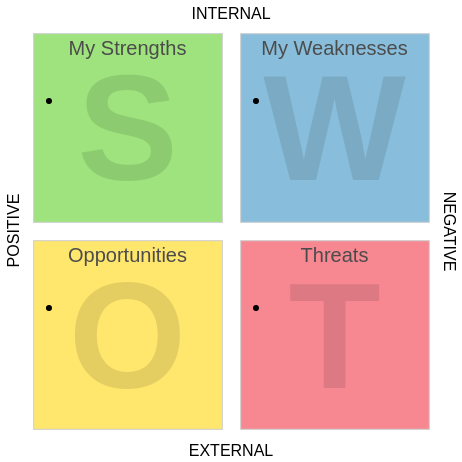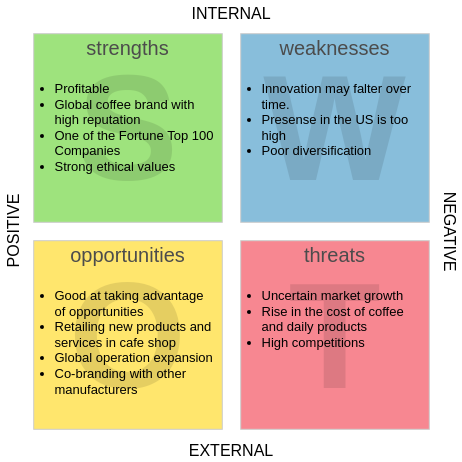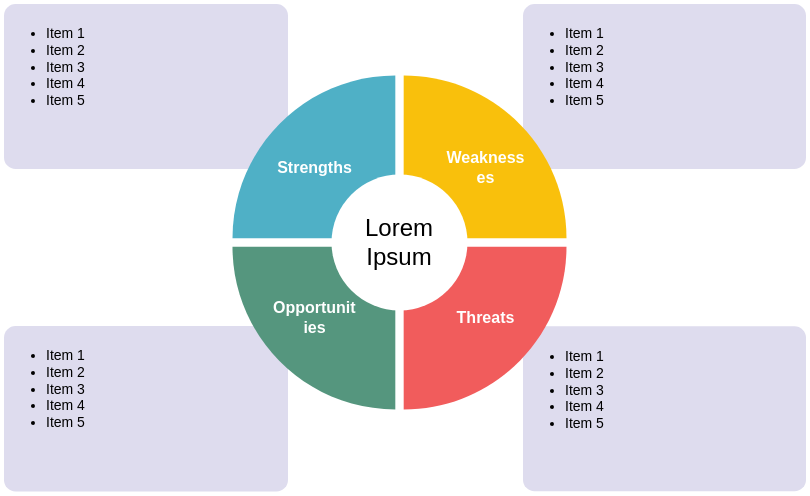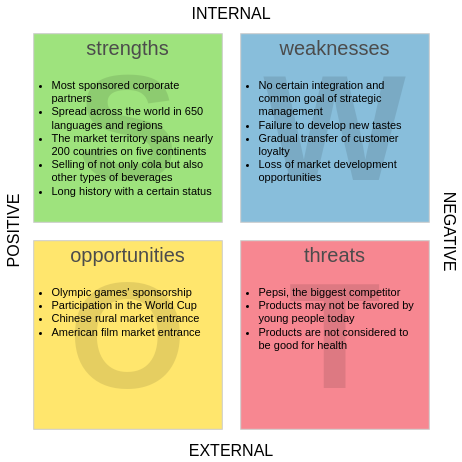Introduction
Nike, Inc., a multinational corporation headquartered in the United States, is a leading global brand in the sports apparel and footwear industry. Known for its iconic “Swoosh” logo and “Just Do It” slogan, Nike has established itself as a powerhouse in the market. A SWOT analysis provides a strategic assessment of Nike’s internal strengths and weaknesses, as well as its external opportunities and threats. This comprehensive article will delve into each quadrant of Nike’s SWOT analysis, drawing insights from the provided outline and adding further details and context.
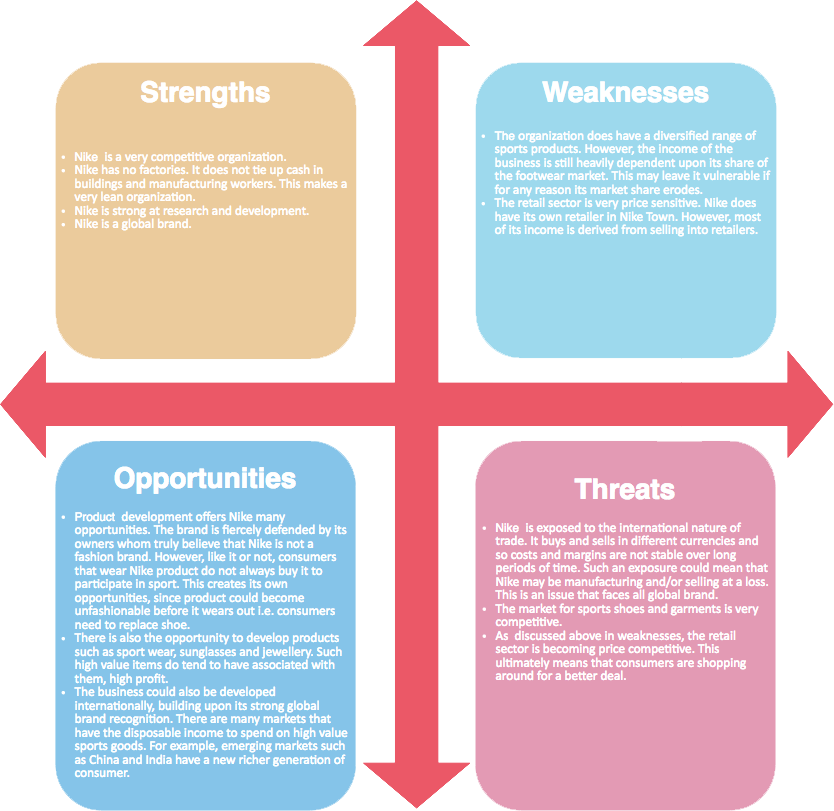
Strengths: Nike’s Unassailable Assets
- Competitive Organization
- Nike’s competitive edge is evident in its robust organizational structure, strategic planning, and operational efficiency.
- The company’s decentralized structure allows regional teams to adapt quickly to local market trends and preferences.
- Nike’s focus on innovation and continuous improvement drives its competitive advantage.
- Strong Brand Reputation
- Nike is globally recognized, with a solid reputation built over decades. Its brand value was estimated at $32.4 billion in 2020, according to Forbes.
- The brand’s association with high-profile athletes, teams, and sports events has further bolstered its reputation.
- Nike’s strong brand allows it to command a premium price compared to competitors.
- Quality and Innovation
- Nike is committed to maintaining high-quality standards, ensuring its products meet consumer expectations.
- The company invests heavily in research and development, driving innovation in materials, design, and technology.
- Nike’s focus on sustainability has also enhanced its brand image, with initiatives like the Move to Zero campaign reducing waste and increasing recycled materials in its products.
- Extensive Product Range
- Nike offers a wide variety of products, including footwear, apparel, equipment, and accessories, catering to various sports and consumer segments.
- Its expansive product range helps Nike stay ahead in the market, appeal to diverse customers, and create cross-selling opportunities.
- Nike’s diverse product offerings also reduce reliance on a single product category, mitigating risk.
Weaknesses: Nike’s Internal Challenges
- Dependence on Footwear Market
- Despite its diverse product range, Nike’s revenue is heavily reliant on footwear sales.
- In 2020, footwear accounted for 65% of Nike’s total revenue. This dependence could be a vulnerability if market conditions for footwear deteriorate.
- To mitigate this risk, Nike should continue to diversify its product range and promote its apparel and equipment categories.
- Price Sensitivity
- The retail sector for sports products is highly price-sensitive, with consumers often opting for lower-priced alternatives.
- While Nike’s strong brand allows it to command a premium, fluctuations in consumer spending patterns and economic conditions can impact its profitability.
- To manage this weakness, Nike should focus on cost optimization, efficient pricing strategies, and maintaining its competitive advantage through innovation and quality.
Opportunities: Nike’s Growth Prospects
- Product Development
- There are numerous opportunities for Nike to develop new products, catering to evolving consumer preferences and market trends.
- Nike can leverage its strong brand value and consumer insights to create innovative, desirable products.
- Emerging trends, such as the growing demand for sustainable and eco-friendly products, offer avenues for Nike to innovate and stay relevant.
- Leisure and Sports Wear
- The lines between leisure and sportswear are blurring, with consumers seeking versatile, comfortable clothing for various activities.
- Nike can capitalize on this trend by developing products that cater to both leisure and sports, expanding its customer base and market share.
- The company’s strong brand reputation and association with athletes can also help drive demand for its leisurewear products.
- International Expansion
- Nike’s strong global brand recognition presents opportunities for expansion into new international markets.
- Emerging markets, such as India, Southeast Asia, and Africa, offer growth potential for Nike, given their growing middle classes and increasing disposable incomes.
- To succeed in these markets, Nike should adopt tailored strategies that cater to local consumer preferences and cultural nuances.
Threats: External Challenges Facing Nike
- International Trade Exposure
- Nike’s global operations are exposed to international trade dynamics, including fluctuations in currency exchange rates, trade tariffs, and geopolitical risks.
- These factors can impact Nike’s costs, margins, and market access, posing significant threats to its business.
- To manage these risks, Nike should diversify its sourcing and manufacturing base, monitor geopolitical developments, and maintain strong relationships with governments and trade organizations.
- Competitive Market
- The market for sports shoes and garments is highly competitive, with both international brands like Adidas, Puma, and Under Armour, as well as local brands in emerging markets, vying for market share.
- These competitors offer similar products at lower prices, posing a threat to Nike’s market position and profitability.
- To maintain its competitive edge, Nike should continue to invest in innovation, marketing, and strategic partnerships, while also optimizing its cost structure.
SWOT analysis
Nike’s SWOT analysis reveals a strong, well-positioned company with significant internal strengths and external opportunities. However, the company also faces weaknesses and threats that could impact its performance if not adequately addressed. By leveraging its strengths and opportunities while mitigating its weaknesses and threats, Nike can continue to solidify its market leadership and drive growth. The company’s ability to adapt to changing market conditions, consumer preferences, and technological advancements will be crucial in maintaining its competitive advantage in the dynamic sports apparel and footwear industry.
A Tool for Creating SWOT Analysis Infographics
Visual Paradigm Online is a user-friendly, web-based visual collaboration and diagramming tool that can help create engaging and informative SWOT analysis visualizations. Here’s why Visual Paradigm Online is an excellent choice for visualizing SWOT analyses:
- Easy-to-use Interface: Visual Paradigm Online offers an intuitive and drag-and-drop interface, making it simple for users to create and customize diagrams without needing advanced technical skills.
- SWOT Analysis Template: The tool provides a pre-built SWOT analysis template, which helps users quickly start creating their diagrams and saves time on layout formatting.
- Customization and Styling: Visual Paradigm Online allows users to customize their SWOT analysis diagrams by changing fonts, colors, and other styling elements. This ensures that the final output aligns with the organization’s branding or presentation requirements.
- Interactive and Animated Diagrams: Users can create interactive and animated SWOT analysis diagrams, making their presentations more engaging and dynamic. This feature is particularly useful when sharing SWOT analyses with stakeholders or during team meetings.
- Real-time Collaboration: Visual Paradigm Online enables real-time collaboration, allowing multiple users to work together on a single SWOT analysis diagram simultaneously. This feature fosters teamwork and streamlines the SWOT analysis creation process.
- Export and Compatibility: Once created, SWOT analysis diagrams can be exported in various formats, such as PNG, PDF, or HTML, ensuring compatibility with popular presentation tools like Microsoft PowerPoint, Google Slides, or email clients.
- Integration: Visual Paradigm Online can integrate with other popular tools and platforms, such as Microsoft Office, Google Drive, and Slack, making it easy to incorporate SWOT analysis visualizations into existing workflows.
- Free and Paid Plans: Visual Paradigm Online offers both free and paid plans, with the free plan providing basic functionality for creating SWOT analysis diagrams. Paid plans unlock additional features and increased export limits.
Steps to Create a SWOT Analysis Diagram using Visual Paradigm Online
- Sign up for a free account on Visual Paradigm Online (https://online.visual-paradigm.com/).
- Click on the “Templates” tab and select the “SWOT Analysis” template.
- Customize the SWOT analysis diagram by adding, editing, or removing elements. Use the drag-and-drop interface to position items as desired.
- Style the diagram by changing fonts, colors, and other formatting elements to match the organization’s branding or presentation requirements.
- Collaborate with team members in real-time by inviting them to work on the diagram together.
- Export the completed SWOT analysis diagram in the desired format for use in presentations, reports, or other communications.
By using Visual Paradigm Online to create SWOT analysis visualizations, users can effectively communicate complex strategic information in an engaging and easy-to-understand format. This tool is particularly useful for teams, organizations, and individuals looking to improve their SWOT analysis presentations and visualizations.




